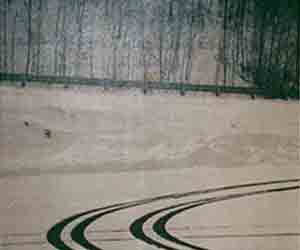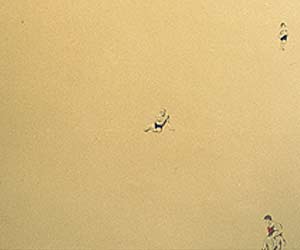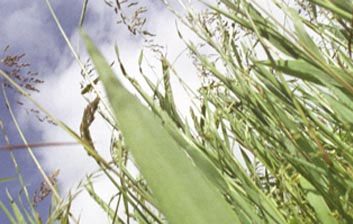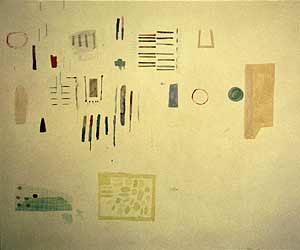In these times of economic frugality and diminishing supports for the arts it is encouraging to know that young Irish artists are carrying on regardless. In Ireland we do not have a tradition of art patronage, a relief or a misfortune depending on your point of view, and young artists can find themselves having to sell out in order to make a crust. On a recent visit to Limerick, I was gladdened to find the city’s exhibition spaces buzzing with the work of young artists.
 |
Emma Louis Johnston: from Scape; courtesy the author |
 |
Emma Louis Johnston: from Scape; courtesy the author |
The Belltable Arts Centre on O’Connell Avenue was showing an exhibition of installation paintings and photographic prints by Emma Louise Johnson. Scape is divided into two sections comprising small square canvases with photographic prints of snowy, austere landscapes and three large wall paintings of figures clad in beachwear. Given the sandy, flat background colour, the attire and poses of the figures in the wall paintings, we can understand that this is intended to be a beach setting. The photo prints on canvas show tyre tracks in snow on roads in a rural setting that shows only small evidence of life. It is a different setting from the wall paintings but resonates with the same mood of dispassion and remoteness. The artist has herself suggested that loneliness is a theme elucidated by the figures in the paintings; they are separate and without interaction. There are no direct signs of personal loneliness, but there is a feeling of isolation that seems to be self-inflicted. Each figure is involved in their own activity and there is no evidence of anyone being necessarily uneasy in their solitude, as there is no visible effort to make contact.
The photographic prints on canvas are quiet, simple and beautiful. The tracks of life are evident without seeing how, or by whom they were made. The patterns left in nature are uncomplicated, curved tracks in snow. These images are processed in colour but there is so little actual colour in the scene that one would be forgiven for thinking they were black-and-white photographs. The visual focus is concentrated on the curved lines and patterns and the coolness of mood. These small canvases exude a quiet confidence and have an honesty that is not achievable in work that has been created to merit saleability.
( Scape is also reviewed in CIRCA 103, on sale from March 7, 2003 – Ed. )
 |
Martin Shannon: from closer…; courtesy Limerick Printmakers |
 |
Martin Shannon: from closer…; courtesy Limerick Printmakers |
Martin Shannon’s latest offering, closer…, was exhibited at the Printmakers Gallery on Robert Street. Four 8′ X 4′ photographs literally interpret the word of the title by bring the subject and object in the images closer to the viewer. Shannon has crafted his work around the viewers’ perspective. This may seem an obvious way to work, but artists are engaging with dwindling frequency in this approach to work. They favour instead the self-assured and sometimes arrogant mode of creating the work with the viewers’ experience of it being an after-thought. A ground-level perspective of a street scene that could be anywhere in Ireland, and a ground-level perspective of grasses swaying against a blue sky are both rendered in colour. The artist has said that he is luring the audience into the centre of the work by enlarging the images to outsized dimensions. It is more evident that he has tweaked the balance between the dimensions of work and of the space in which it is encountered, so that the viewer cannot escape the magnitude of the images and their subject.
There is both visual and conceptual contrast between the images of clothing and the urban and rural landscapes. Check Shirt and Long Sleeve Male are rendered in black and white and even though they are items of personal clothing, the images are sterile and reminiscent of police crime-scene photography. The colour images of the physical world contain lots of minute detail and are evocative of smell, sound, temperature and texture. There is no question that the artist’s technique of exaggerating scale has been triumphant in pushing the environment in closer… directly in the path of the viewer.
 |
Helen O’Leary: from The Way Things Are; courtesy the author |
 |
Helen O’Leary: from The Way Things Are; courtesy the author |
 |
Helen O’Leary: from The Way Things Are; courtesy the author |
The Limerick City Art Gallery in Pery Square was host to The Way Things Are, a large-gallery installation by Helen O’Leary. The show had the tone of perception and contextualisation from a child’s perspective, because of the style employed in the painting, drawing and because of the peculiar layout. This exhibition functions as a single entity. The efforts to categorise and quantify are evident in the collection as a unit, as opposed to any single piece of work clarifying the purpose in the title. The gallery rooms and corridors contain a proliferation of blocks of brightly coloured paintings, collections of domestic jars and bottles, nervously drawn graphs, charts and stencils, scrawled room plans, selections of homemade fuel similar to coal lumps, tiles and coloured cylindrical wooden blocks. There is a frenzy of activity and a kind of psychotic diligence to the pursuit of categorisation. O’Leary’s work is an unambiguous and unapologetic statement in a take-it-or-leave manner. She uses her artistic abilities to describe life or, at least, ‘the way things are’. Nothing goes unnoticed or is unaccounted for in this audit of life. The work is bright and sometimes crowded but always a bit crazy in a self-assured way. There is method to this madness, as a complex pattern is weaved with every element having its value and status noted and recorded. This exhibition deserves the time it may take to overcome the idea that the artist could have been a young child. Many of the individual elements could indeed have been the handiwork of a child, but this exhibition functions as a whole and the artist has accomplished the feat of engaging with the complicated dynamic involved in chaos and the ensuing pursuit of exerting order.
This exhibition was completed in part collaboration with Katie Holten.
The Limerick School of Art and Design building on George’s Quay was the location for a performance by Ouch! Electro. Suzanne Geraghty, the driving force in this four-piece ensemble, commences the performance slowly, silently slipping her way through the gathered crowd and positioning herself in the centre of the floor space. She begins to move in a controlled, measured sequence, covering her head with a large red silk scarf. Visually, this performance is on fire, as colour is distinct and minimal, being confined to a red, black and white palette. The simplicity of movement, shape and form serve to focus our attention. It distils a mood of weariness for a prescribed lifestyle to which many of us pay homage. Aurally the sounds are like treacle; bass, slow and dark. The movements develop into a beautiful dance, borrowing shape and form from eastern traditions. The sequence become more animated and dynamic and soon an accordionist, of the Montmartre style, serenades, if not harasses the main performer as she garishly tosses a bunch of fresh flowers in the air, one by one. When the attention turns to a white bar-style counter with an arrangement of large vials of red liquid, Geraghty sips the drinks and spits them at the barman unrepentantly. Some of the glasses fall and smash and the tempo quickens as the unnerved barman ducks and dives to miss the propelled spouts of liquid. The mood has moved from contemplative and mysterious to indignant and disillusioned. The sounds heighten and Geraghty skilfully spills out deep toned lyrics. The drummer, guitarist and bass player let the frustrated rhythm and tune drip from their instruments, enhancing the lethargic, disdainful mood. The performance winds up with a contemptuous routine where Geraghty uneasily poses and pouts in a showcase with all the contempt she can muster. One might assume that, because of this air of condescension for ‘the scene’, the work could be a difficult oeuvre with which to engage. Rather than leaving the audience angst-ridden and fractious, Ouch! Electro have enthralled them and unfolded a negative mood without depressing their spectators. This group are professional and refined in every detail. Performance, a medium that unfortunately has been beaten and murdered in the hands of unskilled artists, has in this instance been manipulated and exploited to its full potential. Ouch! Electro have given us a work that is rich, visually, aurally and conceptually.
These artists are not the new YBA’s or the new version of any jaded movement. Their work is neither in protest to nor in the shadow of a preceding art movement. They each have their own individual voice and we can look forward to hearing more form them in the future.
Regina Gleeson is a freelance writer on art and technology.
Emma Johnson: Scape, Belltable Arts Centre, Limerick, January/February 2003.
Martin Shannon: closer… Printmakers Gallery, Robert Street, Limerick, January/February 2003
Helen O’Leary: The Way Things Are, Limerick City Art Gallery, Pery Square, Limerick, January/February 2003.
Ouch! Electro, Limerick School of Art & Design, Georges Quay, Limerick, January 2003.